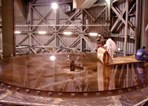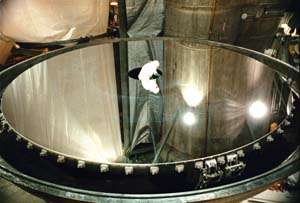8.1-m Gemini Mirror Reaches Mountaintop Observatory

Editor's Report
Astronomers and engineers involved in the Gemini telescope project heaved a sigh of relief earlier this week as the 8.1-m primary mirror for the Gemini South Telescope arrived unscathed at the observatory on the Andean peak of Cerro Pachon in central Chile, successfully passing inspection by technicians.

Designed to operate from near ultraviolet wavelengths to the thermal infrared spectral region (300 nm to 30 µm). The telescope will be a twin to the Gemini instrument already in use on Mauna Kea, HI. Astronomers from the seven country Gemini Partnership will use the telescope to answer fundamental questions ranging from the formation of stellar and planetary systems to the fate and evolution of our Universe.
Primary data on the primary
The telescope is based on a conic form Ritchey-Chretien design; the Cassegrain focus will be used for observations. Formed of Ultra-Low Expansion (ULE) glass (Corning Inc.; Corning, NY) and measuring 8.156 m in diameter at its widest point, the 201.3-mm-thick mirror includes a 1.18 m-diameter aperture at center.
The mirror is solid, not honeycombed. An active optics support system of 120 actuators beneath the mirror and 60 actuators around the edge support the mirror and correct the figure for slowly-varying effects such as thermal distortion, gravitational sag, and inaccuracies in the mirror support system.
The clear aperture of the primary is 8.0 m outside diameter, 1.2 m inside diameter. Over this clear aperture, mirror fabricator REOSC (Saint Pierre-du-Perray; France) achieved a surface figure of 16 nm RMS; surface finish was better than 8 Å rms.
The 1.024-m-diameter Zerodur (Schott Glasswerk; Mainz, Germany) secondary mirror fabricated by Carl Zeiss Optical (Oberkochen, Germany) acts as the stop of the system. "[It allows] chopping with the secondary for background subtraction when observing in the thermal infrared without the instrument seeing the edge of the primary mirror," explains Stepp.
The design includes a 0.167 m-diameter hole designed to eliminate spurious thermal reflections from telescope science instruments during IR observations, ensuring that the light reaching the instrument has only reflected off of the primary and secondary mirror surfaces. "The aperture makes it possible for the infrared science instruments at the Cassegrain focus to see cold sky rather than a reflection of the instrument itself," says Stepp. A cover behind the secondary mirror can be closed during visible observations.
The mirror will be coated with either aluminum or protected silver, applied via a sputtering process in a 9-m-diameter vacuum chamber, located in the observatory on Cerro Pachon.

Performance
The fractional encircled energy for the primary is 80% within a circle 60 milli-arcseconds in diameter, tested at 550 nm. "The resolution of the telescope will normally be limited only by the seeing," says Stepp, noting that on a good night at the observatory, the telescope should achieve resolution to a few tenths of an arcsecond.
Recent results with the Gemini North Telescope on Mauna Kea, using an adaptive optics system from the University of Hawaii, have yielded full-width-half-maximum images better than 100 milli-arcsecond in the near infrared. The group expects similar results for the Gemini South Telescope, which will incorporate an adaptive optics system (wavefront sensor, deformable mirror, etc.) at the Cassegrain focus.
Gemini South is slated to see first light during the second half of this year.
The Gemini 8-m Observatory Project is a multi-national collaboration that will provide full sky coverage to the international astronomy community. Gemini North is expected to go into scientific operation by the middle of this year.
The national research agencies that form the Gemini partnership include: the US National Science Foundation (NSF), the UK Particle Physics and Astronomy Research Council (PPARC), the Canadian National Research Council (NRC), the Chilean Comisión Nacional de Investigación Cientifica y Tecnológica (CONICYT), the Australian Research Council (ARC), the Argentinean Consejo Nacional de Investigaciones Científicas y Técnicas (CONICET) and the Brazilian Conselho Nacional de Pesquisas Cientificas e Tecnológicas (CNPq). The Association of Universities manages the Observatory for Research in Astronomy Inc. (AURA) under a cooperative agreement with the NSF. The NSF also serves as the executive agency for the international partnership.
By: Kristin Lewotsky, Photonics Online
